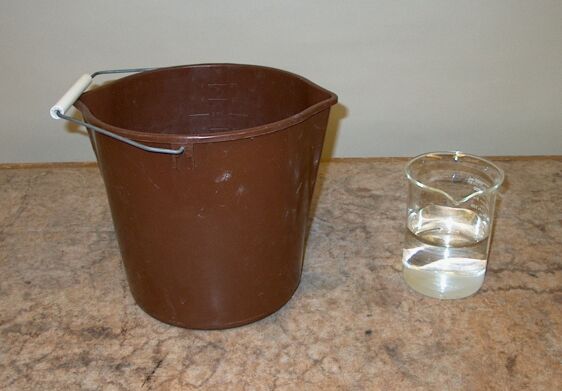
Pour the water (~1/2 liter) into the bucket. Now, holding the bucket at your side, swing it in a vertical circle. As long as you do this so that the bucket has a minimum tangential speed of about 3 m/s, the water will stay in the bucket (and not spill on either you or the floor).
As the previous demonstrations in this chapter show, in order to make a moving object follow a circular path, one must apply a lateral force to the object, which at any given instant points toward the center of the circle. This centripetal force equals mv2/r, where v is the instantaneous tangential velocity of the object, and r is the radius of the circle in which it is traveling. (See demonstration 16.03 -- Ball on turntable.) In the case of an object that is moving in a vertical circle, at the bottom of the circle, the force of gravity (mg, where m is the mass of the object and g is the acceleration of gravity) opposes the centripetal force, so that whatever provides the centripetal force (in the case of the twirling bucket, your arm), must exert a force equal to the centripetal force plus that of gravity in order to keep the object moving in a circle (T = mv2/r + mg). At the top of the circle, though, gravity acts in the same direction as the centripetal force, so that at this point, the tension in whatever provides the centripetal force is reduced by an amount equal to the force of gravity on the object (T = mv2/r - mg). If the force required to keep the object moving in a circle equals that of gravity, then at the top of the circle, the tension in whatever provides the centripetal force goes to zero (T = mv2/r - mg = 0), but the object continues in a circle. If gravity exceeds the centripetal force, the tension becomes negative. In the case of a ball being twirled on a string in a vertical circle, for example, the string goes slack, and the ball falls below the circular path. In the case of the bucket with water, the water falls below the bottom of the bucket. If gravity exceeds the centripetal force by enough, the water spills out of the bucket.
So we see that as long as the centripetal force equals or exceeds the force of gravity, or the centripetal acceleration equals or exceeds the acceleration of gravity, the water stays in the bucket. That is, for the water to stay in the bucket, mv2/r ≥ mg, or v2/r ≥ g. If we take the radius of the circle in which the bucket move as being about 0.9 m (from your shoulder to the bottom of the bucket), then v2/0.9 m ≥ 9.8 m/s2, and v ≥ 3 m/s.